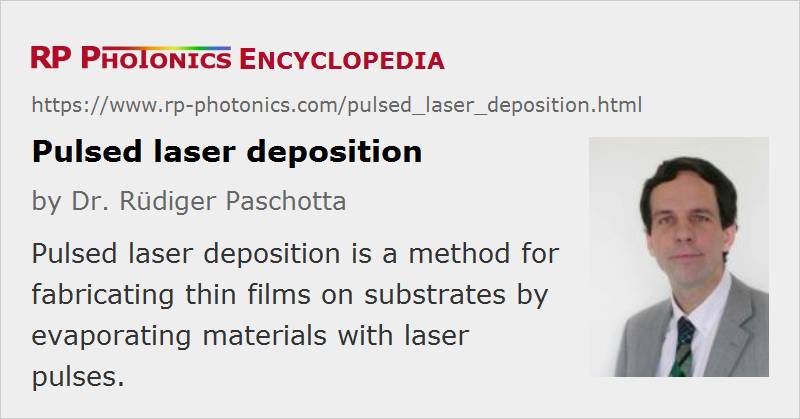Pulsed Laser Deposition
Acronym: PLD
Definition: a method for fabricating thin films on substrates by evaporating materials with laser pulses
How to cite the article; suggest additional literature
Author: Dr. Rüdiger Paschotta
Pulsed laser deposition is a method for fabricating thin films of various materials. Within an ultrahigh vacuum chamber, a solid (typically ceramic) target is illuminated with short high-energy laser pulses, which ablate some material via thermal or non-thermal processes. The ablated material is deposited on a substrate as a thin film of amorphous or crystalline material. The number of laser pulses is adjusted to obtain the required material thickness.
Ideally, the laser pulses should have a short wavelength in the ultraviolet spectral region. Therefore, one typically uses either Q-switched lasers in combination with nonlinear frequency converters, or excimer lasers which directly generate UV light.
Pulses with a rise time of only a few nanoseconds allow not only efficient non-thermal ablation, but also precise preservation of the stoichiometry of the target material. This is an important advantage of pulsed laser deposition over other deposition techniques. It is important e.g. for the production of complex ceramic materials such as high-temperature superconductors or magnetic materials.
Questions and Comments from Users
Here you can submit questions and comments. As far as they get accepted by the author, they will appear above this paragraph together with the author’s answer. The author will decide on acceptance based on certain criteria. Essentially, the issue must be of sufficiently broad interest.
Please do not enter personal data here; we would otherwise delete it soon. (See also our privacy declaration.) If you wish to receive personal feedback or consultancy from the author, please contact him e.g. via e-mail.
By submitting the information, you give your consent to the potential publication of your inputs on our website according to our rules. (If you later retract your consent, we will delete those inputs.) As your inputs are first reviewed by the author, they may be published with some delay.
See also: excimer lasers, laser applications
and other articles in the category light pulses
 |




If you like this page, please share the link with your friends and colleagues, e.g. via social media:
These sharing buttons are implemented in a privacy-friendly way!